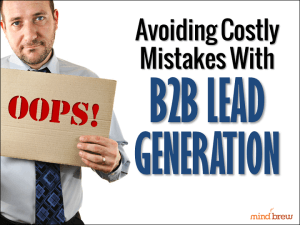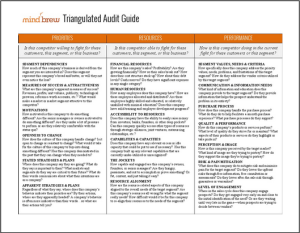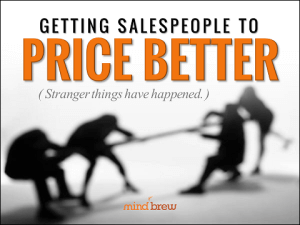Leads are the lifeblood of any B2B sales organization.
Without leads, the salespeople don’t know where to focus their activities. Their only real option is to cold call prospects who may or may not be interested in your products. Without good leads, sales figures plummet—and sales commissions fall right along with them.
It’s understandable then, that the quality and quantity of leads is a frequent source of criticism from the sales team. But diagnosing and fixing lead generation problems is a very tricky business because there are so many different things that could be going wrong.
If your sales team believes that they are not getting enough leads or enough good leads, here are 10 things that could be the source of the problem:
- Using the wrong marketing mechanisms or media. Sometimes B2B organizations focus their marketing in a particular area—social media or trade shows, for example—without really making sure that their target audience regularly engages with the particular mechanism or media that they have chosen. Let your prospects’ habits drive your marketing choices. You should go to them rather than expecting them to come to you.
- Poor negotiation with media outlets. Many B2B companies end up with sky-high cost-per-lead numbers because they aren’t doing a good job of negotiating with their advertising vendors. Your marketing team can’t be afraid to ask for lower rates or lead guarantees on content marketing opportunities. Companies should be ready walk away if a particular outlet doesn’t make sense from a cost-per-lead standpoint.
- Expensive production for lead gen content. Creating interesting white papers, videos, ads, and other lead-gen materials can be very costly, driving up your cost-per-lead. If a particular piece of content is working well for you, keep using it. Whenever you can, repackage or repurpose your existing materials rather than creating new content from scratch.
- Low close rates due to lack of sales ability. Sometimes the problem with the leads isn’t really a problem with the leads at all—it’s a problem with the sales team. In your diagnosis efforts, don’t forget to consider the possibility that the sales team really is getting plenty of good leads, but they just don’t have the skills necessary to close the sale. Perhaps a training or mentoring program could help.
- Low profitability on the deals being closed. Sometimes marketing is generating plenty of leads, but they are the wrong kind of leads. Perhaps the leads they are finding only need your low-margin products or they are price buyers or they have some other characteristic that causes their deals to be less profitable. Alternatively, the problem could be that the sales team is bad at negotiating or simply isn’t paying enough attention to price targets.
- Low customer lifetime value. Some lead gen programs find customers who need your product one time, but don’t buy on a regular basis. For the maximum bang for the buck, make sure that your efforts are targeting customers who are going to need a lot of your products and services over the long term.
- Poor cultivation strategies and mechanisms. It could also be a possibility that you have good leads coming in, but no good strategy or process for converting those leads into sales. The breakdown could be not with the sales people themselves or the leads, but with the cultivation methods you’re currently using.
- Poor targeting and lead qualification. This is a very common source of problems with lead generation. If you haven’t done a good job segmenting and targeting your lead gen efforts, you’re never going to get the kind of leads you need. If you think this might be your problem, check out the webinar on How to Identify & Target Your Best Prospects.
- Unattractive lead gen “bait.” It may be that you aren’t getting any new leads because you aren’t offering prospects something they want. For example, if you’re lead gen bait is a white paper with a title like “Why Company X Is the Best Thing Since Sliced Bread,” of course no one is going to be clicking and downloading. Make sure that any content you offer as lead gen bait is of real interest and value to your prospects rather than just flogging your products and services.
- Requiring prospects to jump too many hurdles. If you’re asking people to give you their name, their company name, their industry, their address, their telephone number, their email address, the number of employees at their company, their annual revenue numbers, and a ton of other qualifying questions before they can download a white paper, guess what? You aren’t going to get a lot of leads from that white paper. Instead, keep the hurdles really low in the early stages. Just ask for a name and email address, or maybe consider giving some content away without a gate at all. You can ask for more information later in the process as the prospects become more and more interested in engaging with your company.
With all these potential pitfalls, it’s no wonder so many B2B companies struggle with lead gen. For more in-depth tips on how to get it right, check out the webinar Avoiding Costly Mistakes in B2B Lead Generation.











